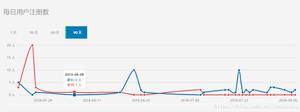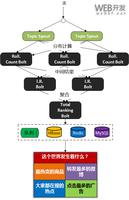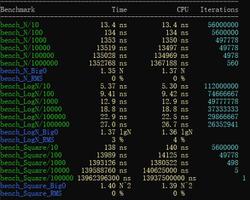计算事件之间的时间
我有一条流经多个系统的消息,每个系统都会记录消息的进入和退出以及时间戳和uuid messageId。我通过以下方式提取所有日志:
filebeat --> logstash --> elastic search --> kibana结果,我现在有以下事件:
@timestamp messageId event May 19th 2016, 02:55:29.003 00e02f2f-32d5-9509-870a-f80e54dc8775 system1Enter
May 19th 2016, 02:55:29.200 00e02f2f-32d5-9509-870a-f80e54dc8775 system1Exit
May 19th 2016, 02:55:29.205 00e02f2f-32d5-9509-870a-f80e54dc8775 system2Enter
May 19th 2016, 02:55:29.453 00e02f2f-32d5-9509-870a-f80e54dc8775 system2Exit
我想生成一个报告(最好是堆积的条或列),用于每个系统的时间:
messageId in1:1->2:in200e02f2f-32d5-9509-870a-f80e54dc8775 197:5:248
做这个的最好方式是什么?Logstash过滤器?kibana计算字段?
回答:
您只能使用Logstash
aggregate过滤器来实现此目的,但是,您必须实质性地重新实现该elapsed过滤器已经完成的功能,这样会很丢人吧?
然后,让我们混合使用Logstash
aggregate过滤器和elapsedfilter。后者用于测量每个阶段的时间,而前者用于将所有计时信息汇总到最后一个事件中。
旁注:您可能想重新考虑您的时间戳格式,使其更符合解析标准。我将它们转换为ISO 8601以使其更易于解析,但是可以随意滚动自己的正则表达式。
因此,我从以下日志开始:
2016-05-19T02:55:29.003 00e02f2f-32d5-9509-870a-f80e54dc8775 system1Enter2016-05-19T02:55:29.200 00e02f2f-32d5-9509-870a-f80e54dc8775 system1Exit
2016-05-19T02:55:29.205 00e02f2f-32d5-9509-870a-f80e54dc8775 system2Enter
2016-05-19T02:55:29.453 00e02f2f-32d5-9509-870a-f80e54dc8775 system2Exit
首先,我使用三个elapsed过滤器(每个阶段一个in1,1->2然后使用in2),然后使用三个聚合过滤器以收集所有时序信息。看起来像这样:
filter { grok {
match => ["message", "%{TIMESTAMP_ISO8601:timestamp} %{UUID:messageId} %{WORD:event}"]
add_tag => [ "%{event}" ]
}
date {
match => [ "timestamp", "ISO8601"]
}
# Measures the execution time of system1
elapsed {
unique_id_field => "messageId"
start_tag => "system1Enter"
end_tag => "system1Exit"
new_event_on_match => true
add_tag => ["in1"]
}
# Measures the execution time of system2
elapsed {
unique_id_field => "messageId"
start_tag => "system2Enter"
end_tag => "system2Exit"
new_event_on_match => true
add_tag => ["in2"]
}
# Measures the time between system1 and system2
elapsed {
unique_id_field => "messageId"
start_tag => "system1Exit"
end_tag => "system2Enter"
new_event_on_match => true
add_tag => ["1->2"]
}
# Records the execution time of system1
if "in1" in [tags] and "elapsed" in [tags] {
aggregate {
task_id => "%{messageId}"
code => "map['report'] = [(event['elapsed_time']*1000).to_i]"
map_action => "create"
}
}
# Records the time between system1 and system2
if "1->2" in [tags] and "elapsed" in [tags] {
aggregate {
task_id => "%{messageId}"
code => "map['report'] << (event['elapsed_time']*1000).to_i"
map_action => "update"
}
}
# Records the execution time of system2
if "in2" in [tags] and "elapsed" in [tags] {
aggregate {
task_id => "%{messageId}"
code => "map['report'] << (event['elapsed_time']*1000).to_i; event['report'] = map['report'].join(':')"
map_action => "update"
end_of_task => true
}
}
}
在前两个事件之后,您将获得一个类似这样的新事件,该事件表明在system1中已经花费了197ms:
{ "@timestamp" => "2016-05-21T04:20:51.731Z",
"tags" => [ "elapsed", "elapsed_match", "in1" ],
"elapsed_time" => 0.197,
"messageId" => "00e02f2f-32d5-9509-870a-f80e54dc8775",
"elapsed_timestamp_start" => "2016-05-19T00:55:29.003Z"
}
在第三个事件之后,您将获得一个类似这样的事件,该事件显示在system1和system2之间花费了多少时间,即5毫秒:
{ "@timestamp" => "2016-05-21T04:20:51.734Z",
"tags" => [ "elapsed", "elapsed_match", "1->2" ],
"elapsed_time" => 0.005,
"messageId" => "00e02f2f-32d5-9509-870a-f80e54dc8775",
"elapsed_timestamp_start" => "2016-05-19T00:55:29.200Z"
}
在第四个事件之后,您将获得一个类似这样的新事件,该事件显示了system2中花费了多少时间,即248ms。该事件还包含一个report字段,其中包含消息的所有计时信息
{ "@timestamp" => "2016-05-21T04:20:51.736Z",
"tags" => [ "elapsed", "elapsed_match", "in2" ],
"elapsed_time" => 0.248,
"messageId" => "00e02f2f-32d5-9509-870a-f80e54dc8775",
"elapsed_timestamp_start" => "2016-05-19T00:55:29.205Z"
"report" => "197:5:248"
}
以上是 计算事件之间的时间 的全部内容, 来源链接: utcz.com/qa/403519.html






